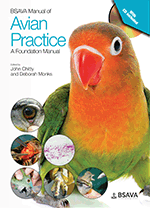
Full text loading...

The sick baby bird is a commonly presented patient at any practice dealing with birds. Frequently presented as emergencies, sick chicks tend to decompensate faster than adult birds, which necessitates a quicker, more targeted approach to diagnosis and treatment. This chapter details the special considerations in practice management, clinical assessment and treatment required by avian paediatric medicine. Case examples: Cockatiel chick with bacterial crop infection; Eclectus Parrot chick with crop fistula; Suspected polyomavirus in hand-reared chicks.
The sick baby bird, Page 1 of 1
< Previous page | Next page > /docserver/preview/fulltext/10.22233/9781910443323/9781910443323.31-1.gif

Full text loading...










